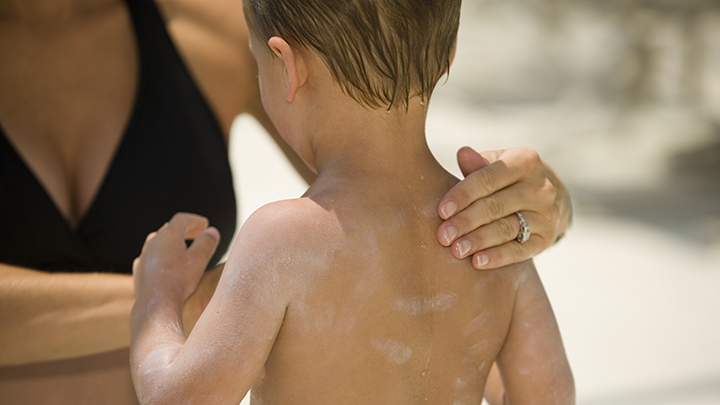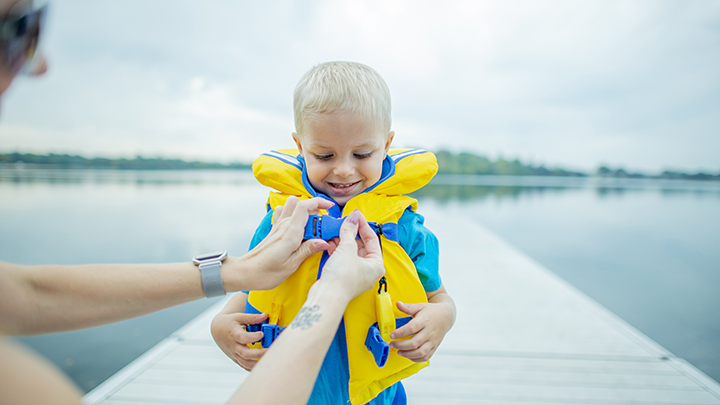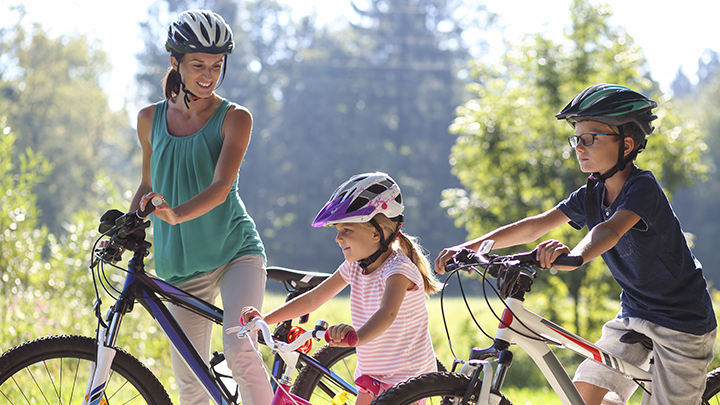
May 26, 2020

Apply sunscreen when you’re outside every two hours all year long.
In Alberta, every bicycle rider under age 18 (passengers included) must wear a properly-fitted, safety-certified helmet. Here’s how to choose and fit a cycling helmet:
For more on fitting a helmet, take our Helmet Yes Test at MyHealth.Alberta.ca.

Children need to wear a properly fitted life jacket when in or near water, especially if they are weak swimmers.

Young children always need to ride their bikes with an adult. They need supervision and help learning about the risks and rules of riding on roads and pathways.
It’s the time of the year when the outdoors call out to families. As COVID-19 continues, physical distancing and thorough hand-washing will be part of enjoying the outdoors. At the same time, keep in mind these everyday outdoor safety practices for the summer. And, of course, remember to have fun.
“In a province as sunny as Alberta, wearing sunscreen is important,” says Dr. Brent Friesen. He’s a medical officer of health with Alberta Health Services (AHS). “You need to wear sunscreen year round on the parts of your body exposed to the sun.”
Babies are especially sensitive to the sun because their sun is thin and can burn easily. Keep them out of the sun.
In adults and at a minimum, the sun can dry and prematurely age your skin. Too much sun can lead to skin cancer, which accounts for one-third new cancer cases in Canada. About 90 per cent of skin cancers are linked to sun exposure.
Sunscreen is one way to protect yourself from the sun. Choose a broad-spectrum sunscreen, which protects from both UVA and UVB rays. See more about sun protection factor at MyHealth.Alberta.ca.
Using sunscreen on babies younger than six months old is not recommended. For babies over six months old, ask your healthcare provider before using sunscreen.
Anyone one year old and up needs to wear sunscreen. Ideally, apply it 15 to 30 minutes before you go outside. Reapply every two hours—and don’t skimp. For adults, use about one ounce (35 millilitres) of sunscreen each time. That works out to applying a dollop of sunscreen the size of two stacked loonies on each arm and leg, and another dollop for your front, one for your back and one on your neck and face. (Seven dollops in all.)
Also use SPF 30 lip balm on your children.
Re-apply sunscreen every two hours or after getting wet or sweaty. Wash off sunscreen with soap and water when it’s not needed anymore.
Others ways to protect you and your family from the sun include:
One more thing — just say “no” to artificial tanning beds. They can increase your risk of skin cancer by more than 50 per cent.
During spring and summer, you also want to avoid the risks of sunburn, and heat-related illness, such as heat exhaustion and sunstroke.”
Young children and older adults are more prone to heat exhaustion and dehydration than older children and adults.
Don’t let the fun evaporate, so to speak. Stay hydrated. Plan ahead. Proper hydration begins the night before.
Carry a backpack with bottled water and healthy snacks, such as fruits and vegetables.
Drink lots of water and other non-alcoholic, non-caffeinated beverages.
Watch for symptoms of heatstroke. Especially keep an eye on children and older adults. A person can get heatstroke without exerting themselves. Symptoms include:
See more about heatstroke at MyHealth.Alberta.ca.
Think about it. Mosquitoes can’t bite you if they can’t find you.
The best way to give them the slip is to:
Be proactive. Around the home, repair any holes in window and door screens. Keep outside doors closed. Outside, use mosquito netting or screened enclosures to protect your family.
Rid your yard of standing water. It’s where mosquitoes like to lay their eggs. Look for any place where water can collect — a bird bath, unattended pet watering bowl or a plain old bucket. As well, empty your children’s wading pool when not in use.
Riding a bicycle is a fun activity for families.
To get the most enjoyment out of cycling, make sure everyone is safe. These are a few of the things to consider.
See more about helmets and bike safety at Healthy Parents Healthy Children.
Bike shops across the province have adopted COVID-19 precautions. They’ve seen a surge in demand for bikes and bike tuning, meaning you may have to book or wait for service.
Just like reading and writing literacy, learning to move with confidence is an important life skill. Children build their physical literacy by doing different physical activities in different setting. The goal is to become competent and confident in basic movements such as running, jumping, kicking, throwing and catching.
Exploring and learning these skills support brain development, social skills, and builds self-esteem and confidence.
Learning physical literacy needs to balance risk with safe equipment, a safe environment and safe supervision right for children’s ages.
For example, children can learn to ride a bike at a young age. They only fully understand the risks of traffic between the ages of 10 and 14.
When choosing activities, consider your child’s physical abilities and other developmental abilities. Are they ready to play a team sport? Can they follow a game’s rules? Do they understand what they need to do to be safe?
Michelle Hodder is a health promotion facilitator with Alberta Health Services. She’s actively involved with Grande Prairie and Area Safe Communities. The community group teaches Grade 1 to 6 students about home, rural and traffic safety.
“When I talk to kids, I say: ‘Use what you have in front of you. Certain things are negotiable, certain things are not,” she says. “When it comes to wearing a helmet, that’s not negotiable. ‘You don’t get on a bike without one’.”
Water, sun and warm weather go together naturally.
But where there’s water, water awareness is needed. Children need to know the risks of being around water.
They also need to wear a properly fitted life jacket when in or near water, especially if they are weak swimmers. Parents and caregivers need to constantly supervise children around water, however deep. One inch (25 mm) of water is enough to cover a child’s mouth and nose.
Constant supervision is vital for a safe family outing. Life jackets and can help keep your child’s head above water, but can never replace your watchful eyes. You need to be within reach and sight when your children are near water.
Teaching your children to swim will also improve their safety and comfort around water. While community lessons are not currently available, Parents magazine offers smart online tips on how you can teach your kids to swim at every age.
If you have a backyard pool, ensure you have a locked, self-closing gate so children cannot wander into your yard. Deflate and turn upside down inflatable or temporary pools when an adult is not around to supervise.
This time of year, also keep in mind spring runoff and swift currents may have eroded hiking trails along river banks from underneath, leaving an overhang that can easily give way.
Visit MyHealth.Alberta.ca for more information about water safety.
With weeks being at home for weeks and as summer approaches, children are drawn to windows and balconies. Both pose potential hazards.
Beware of open windows. Remember, screens are designed to keep bugs out. They will not keep children in. Install window guards on all windows on the second floor and above. These act like gates in front of windows.
Move furniture such as cribs, beds, stools and change tables away from windows to prevent access to them.
Outside, children may climb on furniture and items stored on balconies and decks. This can lead to a fall over a railing. It’s best to remove these if you have children at home.
You can also consider installing safety devices limiting a window’s opening to a maximum of four inches (10 cm).
When it comes to curtain and blind cords, keep them out of reach of children. Wrap any excess cord around cleats, or tie-down devices placed high on the wall, to avoid a choking hazard.
For many Albertans, exploring the countryside by all-terrain vehicles is their favourite warm-weather activity.
Fun as these machines may be, they have risks. Especially for children under 16 years of age, who do not always the strength, skills or judgment needed to operate an ATV.
AHS advises against children under 16 years of age drive or ride on an ATV. This includes ATVs marketed as “child-sized.”
For Albertans 16 years and older, training, safety gear (including a helmet meeting standards for motorcycle use) and buckling up are highly recommended. For more details and tips, see the ATV Safety Toolkit.
Here’s the straight goods on trampolines: they’re a high-risk activity and can lead to serious injuries for children and youth.
In 2018, more than 1,500 kids in Alberta (from infants to 14 year olds) ended up in an emergency department because of a trampoline injury. Ouch!
Safety netting, padding and your close supervision still don’t lower the risk of injury. The Canadian Paediatric Society reports most of the harm is on the trampoline itself.
The society and Alberta Health Services both advise against having a trampoline at your home, cottage or summer home.
Encourage your kids instead to ride a bike, play catch or jump rope.
Learn more about trampolines and bouncers at MyHealth.Alberta.ca.